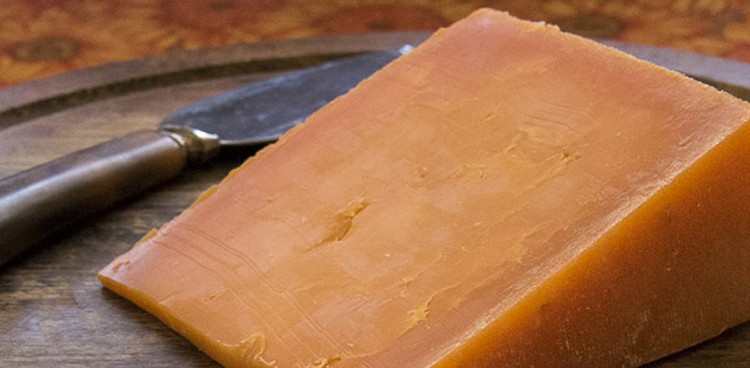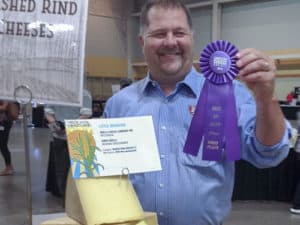

Planet Cheese is a weekly blog devoted to everything cheese: products, people, places, news, and views. James Beard Award–winning journalist Janet Fletcher writes Planet Cheese from her home in Napa Valley. Janet is the author of Cheese & Wine, Cheese & Beer, and The Cheese Course and an occasional contributor to culture. Visit janetfletcher.com to sign up for Planet Cheese and view Janet’s current schedule of cheese appreciation classes.
When the maker of an American Cheese Society “Best of Show” releases a new cheese, it gets your attention. Or mine, at least. Of course this pumpkin-colored creation would turn heads in any case, but the cheesemaker’s award-winning track record compelled me to go out of my way to score some. Is it a cheddar? Or a riff on French mimolette? And what’s up with that color?
Chris Roelli of Wisconsin’s Roelli Cheese Haus took top honors at the ACS judging last summer for Little Mountain, an Alpine-style wheel. And he preceded that triumph with a gold medal at the 2016 World Championship Cheese for Haus Select (pictured above). Roelli clearly has the touch.
Haus Select is a traditional bandage-wrapped cheddar that veers off the traditional path. For one thing, that hue! Wisconsinites love their orange cheddars—white cheddar is suspect—but Roelli has really gone deep with this one. The interior looks like dark butterscotch candy.
Cheese doesn’t develop this color on its own, although some super-aged Goudas get close. Annatto, a plant-based dye from the same seed that tints achiote paste brick-red, does the job. (It’s commonly used in butter, too.) Most people say annatto contributes no flavor, but I sometimes find an earthy taste in cheeses tinted with it and in achiote paste as well.

Chris Roelli
For Haus Select, Roelli (pronounced like Raleigh) uses traditional cheddar cultures but not exclusively. Like several other domestic cheddar producers, he is aiming for the more mellow character that many American consumers prefer. I asked him if, like others, he was adding Swiss-type cultures to achieve a sweeter, nuttier taste. “I wouldn’t argue with that,” he said.
Made from pasteurized cow’s milk in a 20-pound format, Haus Select ages in cheesecloth for a minimum of four months, although most of the wheels leaving Wisconsin are eight months old or more. But unlike classic clothbound cheddar, Haus Select gets a polymer coating when the wheel is about two weeks old. The coating is permeable so the cheese can breathe, but it keeps the dreaded cheese mites at bay.
These tiny cheese-loving critters can bore through a rind so cheesemakers must frequently brush them off, which takes constant attention. “For my small group of guys, it’s really hard to manage that and to keep the other cheeses safe,” says Roelli. The coating reduces the air exchange that contributes to the development of the great classic cheddars but saves Roelli and his crew a lot of aggravation.
Haus Select is firm and brittle, breaking cleanly. It has subtle nutty and earthy aromas, a pleasant cheddary tartness and a mellow finish. It’s not the most complex cheddar you will ever taste—it lacks the layered flavors I find in the best ones—but it’s an enjoyable snacking cheese and a good choice for people who find traditional cheddars too biting. Roelli tells me the cheese develops protein crystals and more mature aromas at eight to twelve months, so let’s hope he can afford to hold on to some for extended aging.
In Northern California, look for Roelli Haus Select at Farmstead Cheeses and Wines in Alameda and Montclair; Market Hall Foods in Berkeley; Mission Cheese and Cheese Plus in San Francisco; and Atelier by JCB in Yountville. You can also purchase the cheese online at www.roellicheese.com. An American pale ale or cider would be my beverage of choice, but the cheese is mild enough to pair with almost any red wine.




